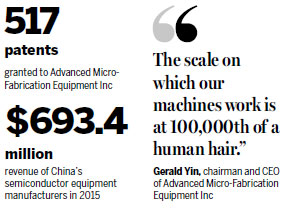Manufacturing on micron scale shows huge computing progress
Every visitor to Advanced Micro-Fabrication Equipment Inc's buildings is required to wear dust-free garments and shoes.
"You would face much more strict environmental measures at our production facilities and labs," said Xiong Yi, a senior marketing specialist at the Shanghai-headquartered company, also known as AMEC.
Chairman and CEO Gerald Yin said, tongue in cheek: "In our plant, you cannot find PM2.5 at all. PM0.25 may be possible." PM2.5 refers to tiny particles or droplets in the air that are 2.5 microns in diameter or smaller.
"The scale on which our machines work is at 100,000th of a human hair," Yin said. "The operation looks as if we are building a sophisticated mall or overpass of more than 10 stories (in this micro world)."
AMEC's etching process alone involves more than 100 steps on this tiny scale. The entire work procedures have 1,000 to 2,000 steps, which require 99.99 percent accuracy to improve profit margins, Yin said.
The company defines itself as an innovative semiconductor equipment provider with proprietary wafer fabrication solutions. Although rarely exposed to the media limelight, semiconductor equipment manufacturing is the very foundation of the high-tech industry eco-system, said Yin, 73, a senior expert with decades of industry experience.

"Such sectors as software, the internet and e-commerce cannot work without electrical machines that are mostly made up of chips," Yin said. "We are one of the manufacturers of the equipment that produces these chips."
Innovation protection
Intellectual property is a sensitive issue in the high-tech industry, he said, adding that since its founding in 2004, AMEC has long valued IP management.
The company has raked in hundreds of millions of yuan in annual revenue and has nearly 500 employees, one-third of them from rival markets in Europe and the United States.
The chairman himself also worked with industry giants including Applied Materials Inc, Lam Research Corp and Tokyo Electron Ltd.
"Once our employees join us, we require them all not to infringe any trade secrets or the patents of their former employers or a third party," Yin said.
At the same time, the company's IP department conducts thorough research into its major competitors' patents and locates potential risks and opportunities, Yin added.
He cited legal disputes with Applied Materials and Lam Research, two heavyweights in the industry, several years ago as examples to illustrate how the company's IP prudence has paid off.
After Applied Materials filed a trade secret claim with a federal court in the US in 2007, AMEC filed a counterclaim in response. The two parties reached a settlement later.
In the patent case filed by Lam Research in Taiwan in 2009, local courts ruled in AMEC's favor.
To date, AMEC has filed more than 1,000 patent applications worldwide, with 517 of them already granted. "Others are still being processed," Yin said.
"It doesn't matter how many patents are granted," he said. "The key is how much they can protect you."
Fast-paced development
Along with the rapid technological progress in computing comes that of chip fabrication.
Yin, a Peking University postgraduate, said the school had the most advanced computer in the country when he studied there in the 1970s. It had only 128 KB storage capacity, yet covered several floors.
When he worked with Intel Corp in Silicon Valley, in the US, 10 years later, a 128K device was reduced one million times in size. The size was again reduced another million times in 2015.
"Our research and development works five to seven years ahead of products rolling out to the market," Yin said.
Data from the Topology Research Institute shows that Chinese semiconductor equipment manufacturers generated 4.7 billion yuan ($693.4 million) in annual revenue last year, 2.1 percent of the world's total. In contrast, China contributed approximately 14 percent of the global market.
Manufacturing equipment accounts for some 70 percent of semiconductor makers' expenditure on chip production lines, industrial insiders said.
wangxin@chinadaily.com.cn
(China Daily 11/09/2016 page17)














